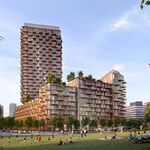San Francisco is an interesting example, since I think in many ways (OK, weather aside) it's a rather similar city to Toronto. SF proper has roughly the same population as the old city of TO, it is the centre of a large, relatively de-centralized urban region with many competing agendas, it has an extremely vibrant urban core that resisted many of the typical maladies of post-war North American cities and is now coping with the pressures of rapid population growth.
And yes, many of its public spaces are shabby. There are overhead wires on frontier-town wooden poles all over., cracked sidewalks and so on. Not so much right in the downtown core, but not far -- and in such a compact city nothing is ever very far.
The other factor worth noting is that SF has a degree of visible poverty that's actually hard to imagine if you haven't spent time there. Walk 60 seconds west from Union Square along Geary (not an exaggeration) and you will be face to face with one of the roughest urban environments in any North American city centre. It makes the Downtown East Side in Vancouver seem pretty manageable. There are tiny pockets of improvement but they are just that, pockets, in a vast landscape of decay. That even the most progressive big city in the US has left this unaddressed for so long will make you question a lot of things about our southern neighbor.
Some years ago the plaza in front of the Ferry Building, on the Embarcadero, was fixed up into a nice park with space for a farmers' market. It's a huge success, but for the fact that about a third of the space is used as a near-permanent encampment for the homeless.
I don't mean this to excuse Toronto's shabbiness in many places at all. When SF does fix things up, for example along the newish Third St light-rail line and, relatedly, around Mission Bay, the results can be gorgeous: nice sidewalks, buried wires, successful street trees, and all the rest. We could learn from that. On the whole, however, I would hesitate to say SF is a city we should be emulating too closely.
Boston on the other hand has a lot to teach us (and others) about maintaining beautiful public spaces.




